The State of the Gulf, Then and Now
Air Date: Week of April 10, 2015
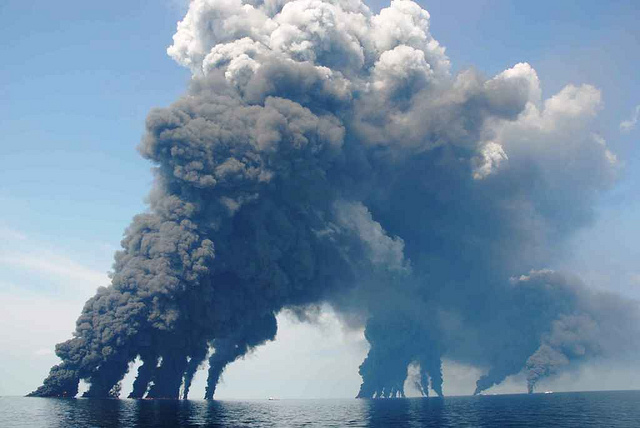
4.9 million barrels of crude oil had escaped the well by the time the flow was staunched, making the Deepwater Horizon oil spill the largest by far ever to occur in U.S.-controlled waters. Cleanup efforts involved gathering and burning the oil. (Photo: SkyTruth, Flickr CC BY-NC-SA 2.0)
Five years ago, the DeepWater Horizon well explosion gushed 200 million gallons of oil into the Gulf of Mexico. Since then, scientists have been examining its effects on the ocean and marine life. In 2012, reporter David Levin chronicled the efforts of a team of chemists, engineers and biologists assessing the overall damage to the Gulf ecosystem. We look back on these events and host Steve Curwood turns to David Hollander, a leading marine chemist involved in this research, for an update on the state of the Gulf today.
Transcript
CURWOOD: It's Living On Earth. I'm Steve Curwood. On April 20, 2010, the Deepwater Horizon oil rig in the Gulf of Mexico exploded, killing eleven workers as a sea bed well blew out and began spewing over 200 million gallons of crude into the Gulf. Since then, science has been trying to understand exactly how such a torrent of oil affects the marine ecosystem. The University of South Florida leads a collaboration of chemists, engineers and biologists investigating this, and as part of updating Living on Earth stories during Earth month we’re catching up on this effort. David Levin went along with the team in 2012, and here is part of his report.
LEVIN: For three straight months, oil sprayed up from the wellhead to the surface, and as it rose, vast plumes of toxic chemicals and oil droplets broke off, staying suspended in the seawater at different depths. They drifted around the Gulf like toxic clouds.
HOLLANDER: This is not a black layer in the ocean. It doesn't even look like vinaigrette when you bring it up. It looks like crystal clear water, and the reason is because they were such fine droplets that you couldn't see them.
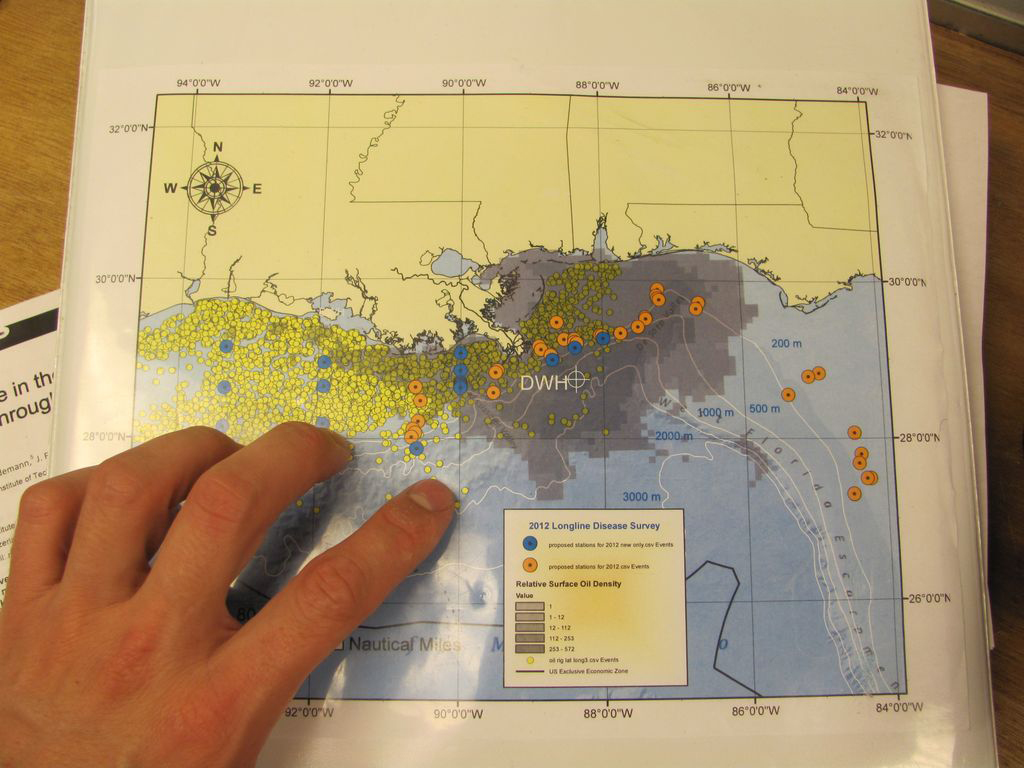
This map shows thousands of oil platforms (represented by yellow dots) scattered throughout the Louisiana and Mississippi Coast in the Gulf of Mexico. White crosshairs mark the site of the Deepwater Horizon disaster, and blue and orange circles represent C-IMAGE sampling sites. (Photo: David Levin)
LEVIN: The underwater plumes eventually floated into the continental slope. That's where the ocean falls out dramatically. It falls from a few hundred feet deep to a few thousand. When the plumes hit the slope, they left a smear of oily residue. Hollander and his team are using this cruise to visit those oil-soaked areas. Their mission: collect both sediment and fish to measure the plume’s impact on the Gulf ecosystem, from huge whales to tiny single-celled animals.
This project’s part of a larger research effort Hollander helped start at USF. He’s organized scientists from around the world to study the aftermath of the spill. The group calls themselves C-IMAGE, and this cruise is the first part of their collaboration.
[CLANKING FOOTSTEPS ON GANGPLANK, ENGINES WHIRRING]
LEVIN: For the next eight days, our home base will be here, on the Weatherbird II, a 115-foot research vessel.
WHITE: Welcome aboard, glad to finally have everybody on board. Looking at a 4 a.m. start, 5 a.m. start…
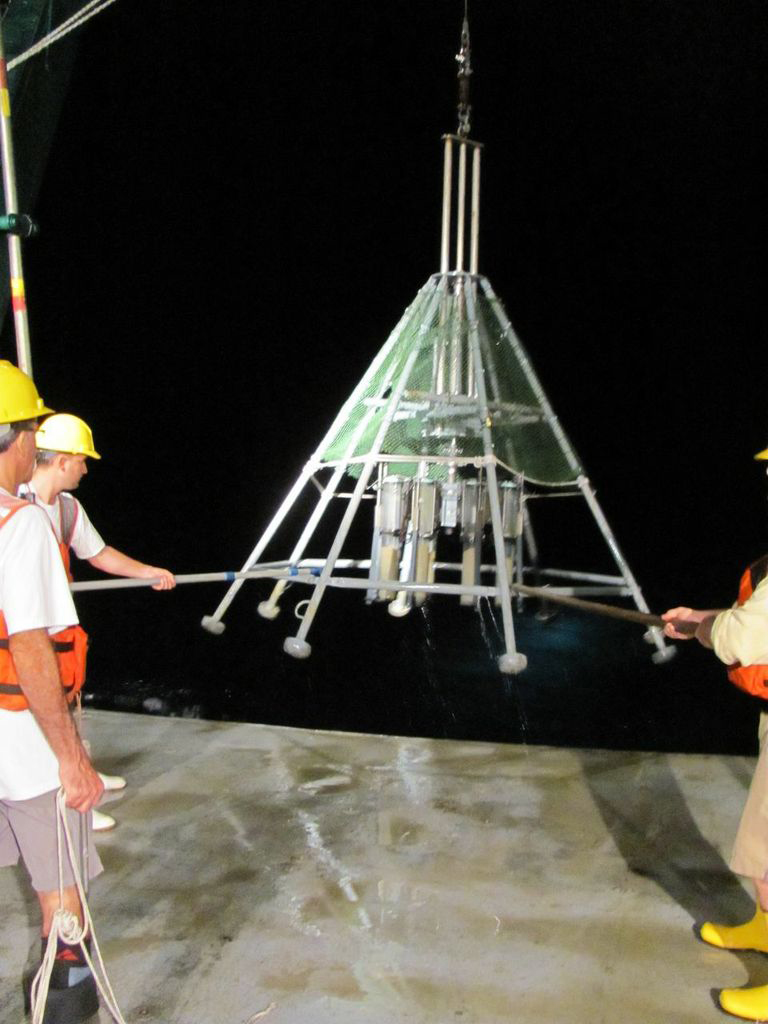
C-IMAGE scientists Patrick Schwing and David Hollander help bring in a multicorer, a device that samples sediment from the ocean floor. Inside the frame are eight thick plastic tubes that sink into the mud when the device hits the bottom, sealing the sediments inside. The samples will help Schwing and Hollander determine the extent to which oil has affected the ecosystem at the bottom of the Gulf of Mexico.
LEVIN: That’s Matt White, the ship’s captain. We’re about to set sail for an area of the sea floor called the Desoto Canyon, about 60 miles southwest of the Florida panhandle. It’s one of the places where the oil plumes bumped into the continental slope.
[CRANE WHIRRING]
By midnight, we’re at our first stop. Hollander’s team lowers a device called a multicorer into the water. It’s a metal frame about 10 feet tall.
SCHWING: The multicorer literally looks like a giant spider, or a giant lunar lander…
LEVIN: Patrick Schwing is a post-doc in Hollander’s lab. He’s watching the multicorer disappear under the waves. When it hits the bottom, eight plastic tubes inside it will grab mud from the seafloor.
SCHWING: …and at that point we start pulling it back up.
LEVIN: These coring samples are crucial for understanding how the spill moved around the Gulf. They’ll help the team predict what happens to oil after a deep-water blowout, and how long it’ll last in the water. But the life of the oil is only half the picture. To understand its impact on the ecosystem, the team needs to know how fish and other animals are faring.
[ON DECK]
MURAWSKI: Look at that sunrise. That’s sharp.
LEVIN: The next day, at 6 in the morning, Steve Murawski stands on deck, holding laundry baskets full of bait.
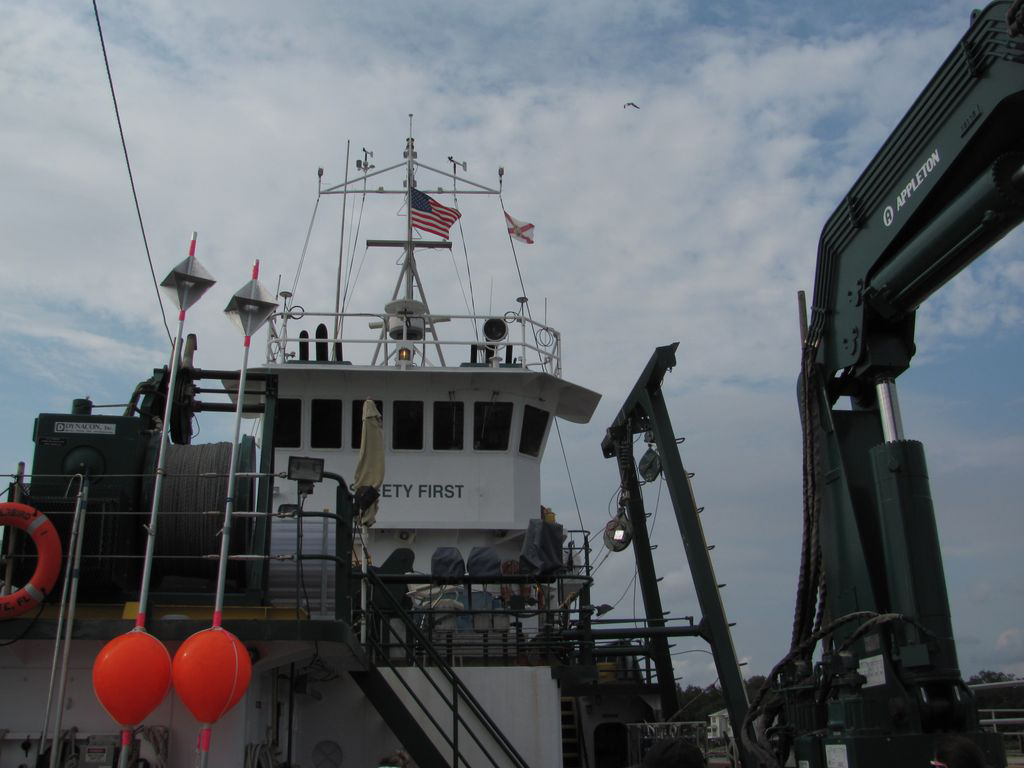
A view forward from the stern deck of the R/V Weatherbird II, the 115-foot research vessel used by C-IMAGE, as it waits to embark on an 8-day research cruise in the Gulf of Mexico. (photo: David Levin)
MURAWSKI: It’s a combination of squid and Boston mackerel…
LEVIN: Murawski is a biological oceanographer at USF, and he’s running this research cruise along with Hollander. He’s setting up for a long day of fishing. His team is using a winch the size of a 50-gallon drum to let out five miles of metal cable. Strung out along the cable are 500 baited hooks. It’s a technique called long-lining. As the cable spools out, it settles across the bottom, attracting fish that live near the oily sediments.
MURAWSKI: It’s a unique opportunity to see what’s going on with the fishes in the really deep water. We know that there’s oil on the bottom. What we’re trying to see is if that oil is having any food chain effects.
LEVIN: Murawski thinks the toxic chemicals may have been absorbed by tiny animals that live in the sediments…like clams, snails, and worms, which all get eaten by fish. So if there’s any oil lower down in the food chain, it might end up in the fish. And if it does, Murawski wants to know. So he’s taking samples from all the species he catches on his long line.
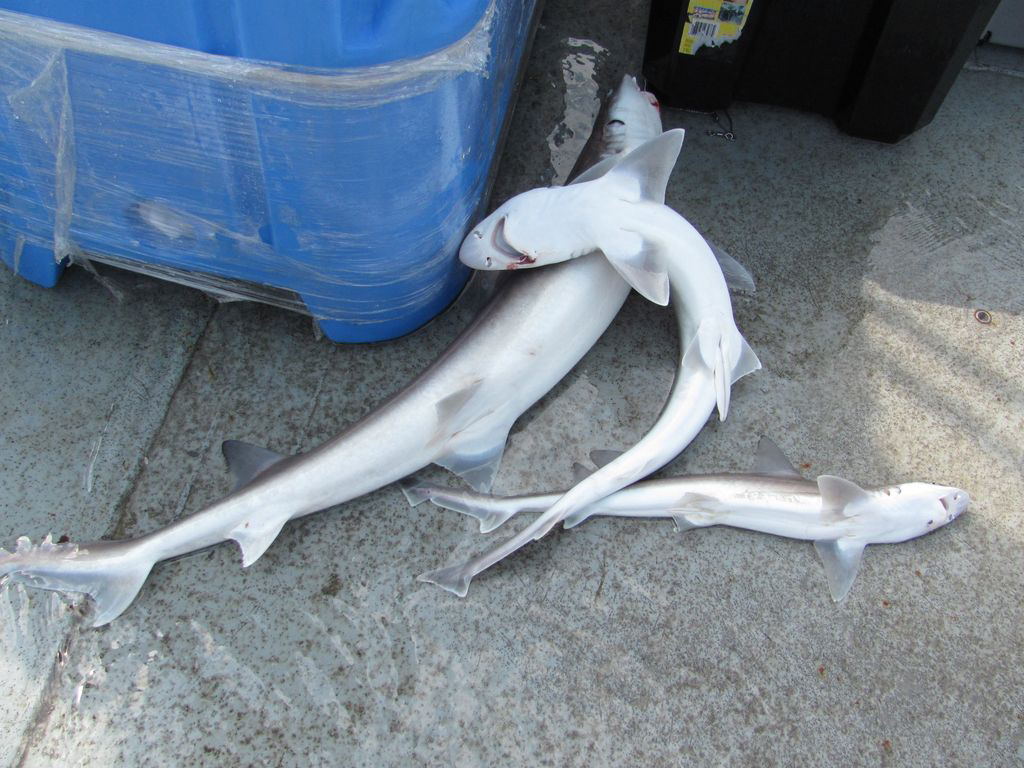
These dogfish (actually type of shark) are common in the Gulf of Mexico, and come up frequently on C-IMAGE fishing lines. (photo: David Levin)
MURAWSKI: So what we're going to do is look at the bile, the blood, the liver, the muscle, and then some of the organs of the fish. So that should tell us number one, is there active oil in the environment, and number two, is it being uptaken by these fish, some of which are of commercial importance.
[FLOPPING FISH ON DECK]
LEVIN: One by one, fish come off the long line and flop onto the deck. Red snapper, Dogfish. Eels. Grouper. Tuna. This part of the research is grueling. Murawski and his students work in 100 degree heat, cutting out fish guts so they can test them for chemicals from the oil.…and when they’re done with that, they reach for the bone saw.
[BONE SAW CUTTING INTO FISH HEAD]
HERDTER: Whoo! Perfect!
LEVIN: Liz Herdter, one of Murawski’s students, just split open the head of a yellowedge grouper. She uses tweezers to pull out delicate bones from its inner ears. They look like tiny oyster shells.
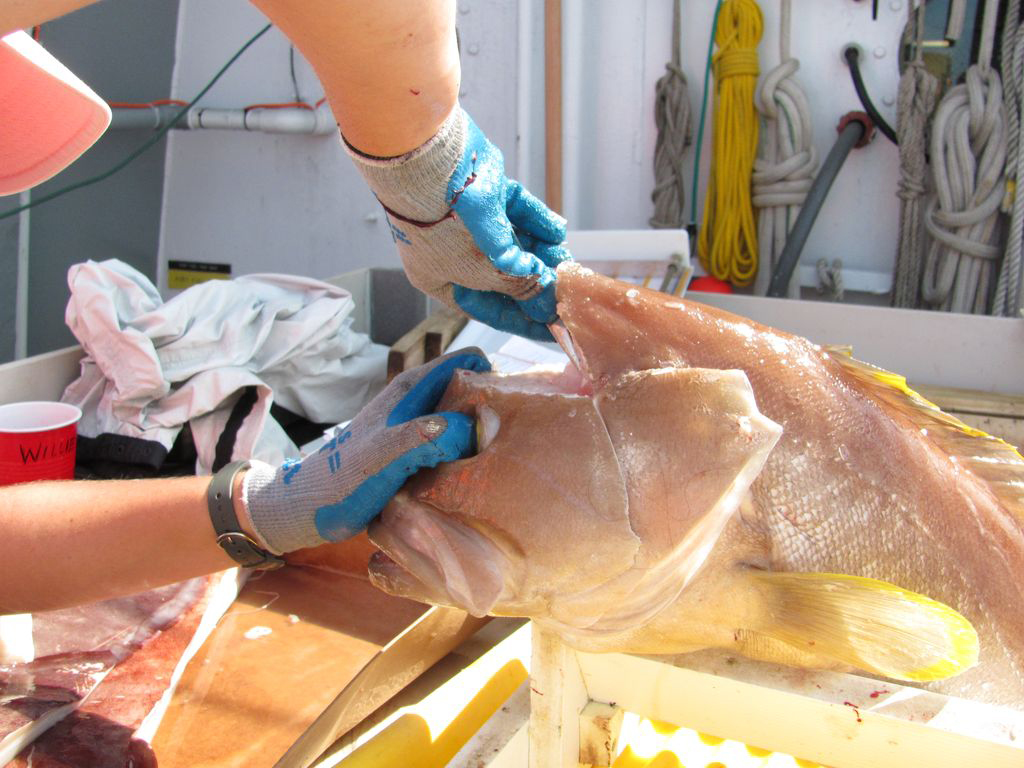
USF Graduate student Liz Herdter carefully removes delicate inner ear bones called "otoliths" from a Yellowedge Grouper. Chemicals trapped in various layers of the otoliths provide a detailed record of the fishes' exposure to toxins throughout its life, and may help provide clues to the fishes' exposure to oil from the Deepwater Horizon spill. (photo: David Levin)
HERDTER: These are otoliths. They’re like an earstone. Steve likes to call it the flight recorder.
LEVIN: That’s because a new layer of bone forms around an otolith every year. They’re laid down like the rings of a tree, and by analyzing these layers; you can track the health of the fish over time.
HERDTER: If they came into contact with any chemicals, there’ll be a chemical marker, so they’re a really neat way to determine what’s been happening in the life of the fish.
LEVIN: Murawski’s team wants to use these samples to create a big-picture view of fish and ecosystem health in the Gulf. Even today, some fish are still in bad shape… Like the 50-pound red snapper Murawski’s holding. It’s got a skin lesion.
MURAWSKI: It’s also got a bad eye! See his eye? His eye’s gone. So this is the kind of fish we want to investigate for whether it has any relationship to oil or not.
LEVIN: Sick fish like this one don’t surprise Murawski. He thinks their bad health is connected to what’s going on in the sediments, and Hollander just found some evidence to back that up. At a work table crammed into a corner of the deck, Hollander points to one of the cores his team pulled up the night before. It’s a clear plastic tube, about two feet long and six inches wide. It’s full of grey mud, where tiny worms, snails, and clams have burrowed, mixing it all up… But a few inches from the top, that uniform grey suddenly turns brown. And that, he says, means trouble.
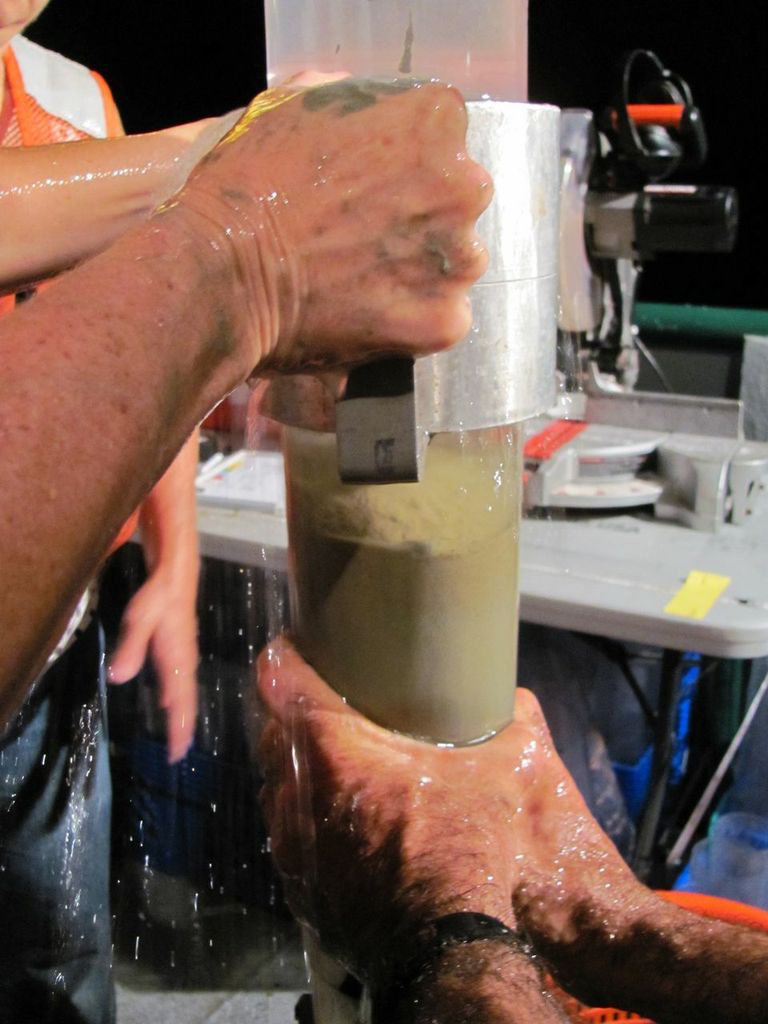
From L to R: C-IMAGE researchers transfer a sediment core sample into a storage tube on the deck of the R/V Weatherbird II. (Photo: David Levin)
HOLLANDER: What this really represents is where the subsurface plumes actually touched the sediment surface.
LEVIN: When the plumes hit the sea floor, they wiped out the tiny creatures that usually mix up the sediment. So after the spill, all that churning activity ground to a halt.
HOLLANDER: If there were organisms mixing this, you wouldn’t find these distinct layers, so those organisms are gone.
LEVIN: In some parts of the Gulf, they still haven’t come back. And since some fish live in and near the sediments, Hollander thinks the chemical plumes probably affected them, too, causing the liver problems and skin lesions Murawski’s been seeing. But it’s hard to know for sure. Figuring out what the toxins may have done to the fish is a challenge, and it’s tough to pinpoint which chemicals could be the culprits.
HOLLANDER: You know, you have to be able to trace the oil from its origin, through the water column, onto the sediments, and then as that material degrades, how do you follow it? Not that easy.
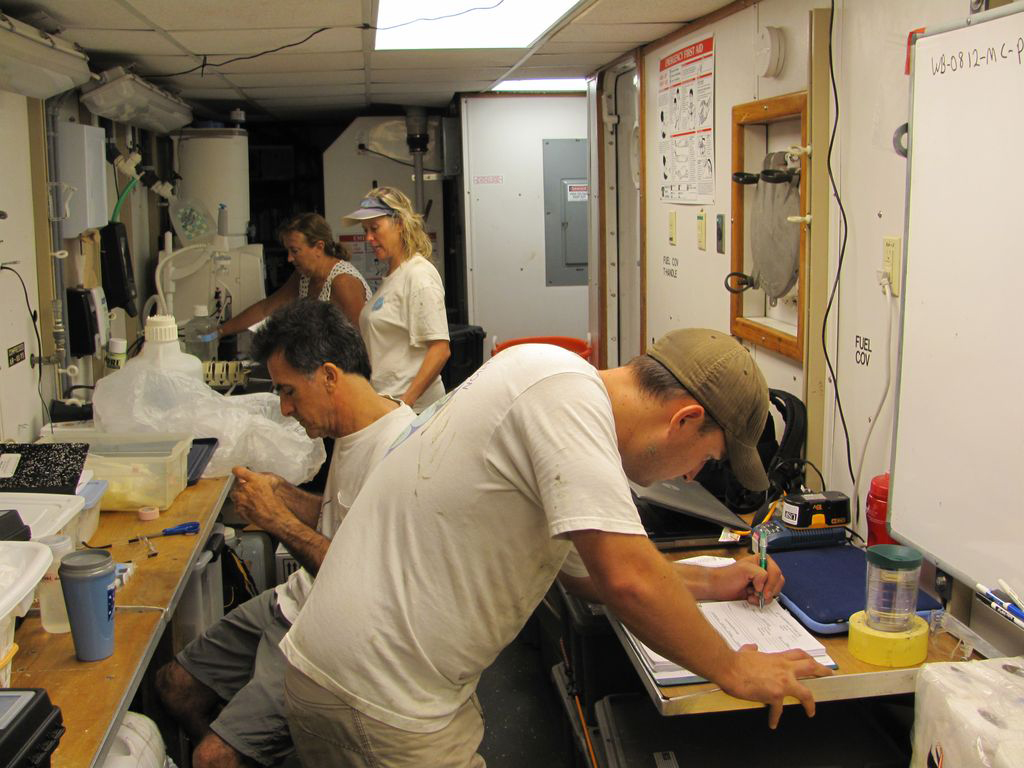
From top to bottom: C-IMAGE researchers Patty Smukall (USF Teacher-At-Sea), Theresa Greely, David Hastings, and Patrick Schwing process samples in the onboard lab lof the RV Weatherbird II. (Photo: David Levin)
CURWOOD: That’s marine chemist David Hollander at the University of South Florida, in David Levin's report on the team studying the long term impact of the DeepWater Horizon catastrophe on the Gulf of Mexico ecosystem. Professor Hollander is a key researcher in this effort, so we called him up to get a handle on new developments and the state of the gulf today. When he spoke to us his parakeets joined in.
[PARAKEETS CHIRPING]
HOLLANDER: We have definitive perspectives on the fisheries that are being affected and are still affected and we have an understanding of their contaminate chemistry and how they got contaminated through the sedimentary system and the deposition of oil onto the sediments. The good news is that it’s recovering. The bad news is that it's still pervasive in the area and we don't have an exact understanding of how long it will last.
CURWOOD: So, what are the affects of all this the fish life down there? What kind of clues do you have?
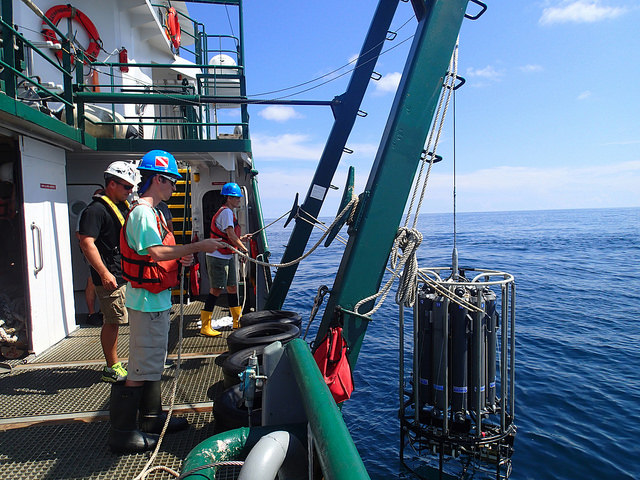
Above, C-IMAGE researchers lower a CTD (Conducticity, Temperature, and Depth) rosette into the Gulf to study the effects of the oil spill on water quality. C-IMAGE is a consortium of 19 institutions in six different countries studying the long-term impacts of the Deepwater Horizon and Ixtoc oil spills on the Gulf of Mexico ecosystem. (Photo: courtesy of C-IMAGE Consortium)
HOLLANDER: The clues actually come from the fish themselves. Hydrocarbons, oil in particular, it's not like a heavy metal, it doesn't accumulate in fish but actually is metabolized and when you measure these compounds, these petroleum hydrocarbons in fish liver and importantly in fish bile, we can see their prevalence in those tissues and those liquids. We've seen a decline since 2010 and 2011 of about 30 to 50 percent, and that does vary by compounds but we are still seeing the persistent contamination of the food that fish are actually consuming especially those that are associated with the bottom and those are called benthic-dependent fish and they make up some of the most important economically and recreational fish species in the northern Gulf of Mexico.
CURWOOD: For example?
HOLLANDER: The Red Snapper, for example, which is a quite common fish in restaurants as well as in recreational fishing. Grouper are another species as well.
CURWOOD: So, Professor, the situation you're seeing there. What kind of ideas, what kind of better ideas does it give us of how we should deal with a future blowout if one were to ever happen?
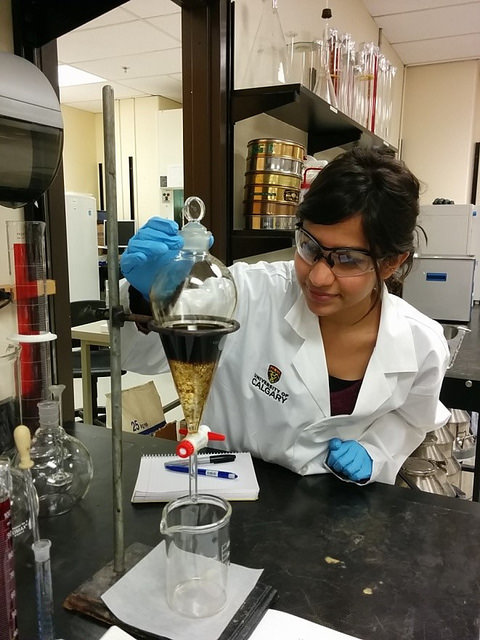
Back at the lab, researchers working with C-IMAGE run tests on samples collected from the Gulf. (Photo: Courtesy of C-IMAGE Consortium)
HOLLANDER: In the case of the Deepwater Horizon there was oil that was marching its way towards the coastline and into the marshes and so the forces that be opened up the floodgates of the Mississippi, opened up the diversionary channels to push freshwater out of the marshes and push the oil into the offshore region. But associated with those waters came a significant amount of clays and nutrients and they had a unexpected consequence, that is, the dispersants were also applied to the oil from the surface as well as oil was skimmed and burned. The oil with dispersants lends itself to smaller droplets, which very, very effectively binds with the clay minerals. The nutrients, which came out of the river system, produced an algal bloom, which in the presence of oil and dispersants, the algae produce a very mucilaginous, very sticky substance. And essentially, it's a stress response by the organisms.
CURWOOD: It sounds like oily snot.
HOLLANDER: That's precisely it. There was actually a term coined ‘sea snot’ to represent the sticky mucilaginous material. So the oil mineral aggregates would adhere very readily to that sticky mucilaginous material with the algae, and all of a sudden you had this combination of oil and mineral and algae material, which were able to sink out of the water very, very quickly. This material was falling like a blizzard, and we coined the term ‘the flocculent dirty blizzard’ because it represented really the process that was going on.
CURWOOD: Now talk to be about the state of the marshes and the rest of the gulf, the beaches, the oyster bed. How have they recovered so far?
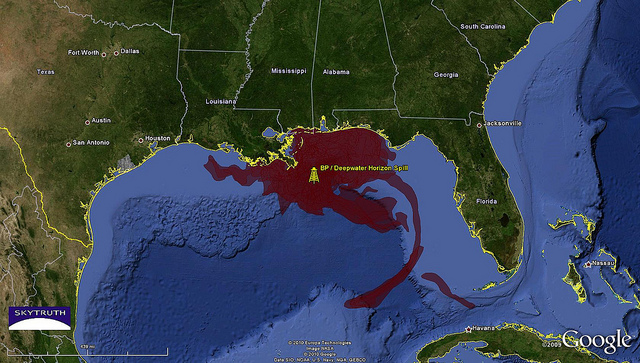
Oil from Deepwater Horizon spread out over 3,850 square miles of the waters in the Gulf. (Photo: SkyTruth, Flickr CC BY-NC-SA 2.0)
HOLLANDER: The oysters were, of course, affected by the opening up of these floodgates of the Mississippi and the diversionary channels. They require a very precise range and salinity and that salinity was dropped significantly and really compromised those oyster beds. They've come back in some locations, in other locations they don't seem to have recovered as strongly. The beaches themselves look pretty good. They use a lot of physical techniques to mix up the oil with the sandy sediments, and that essentially dilutes the oil in the sediment on the beaches, but you can still find very resistant oil molecules and oil molecules that have actually transformed to very bio resistant molecules that have a long-term persistence in the environment.
CURWOOD: Obviously, preventing blowouts is the best possible way to proceed but what are the lessons we should learn as a society, especially about our relationship with oil well extraction from the research that you've done there on the bottom of the Gulf of Mexico.
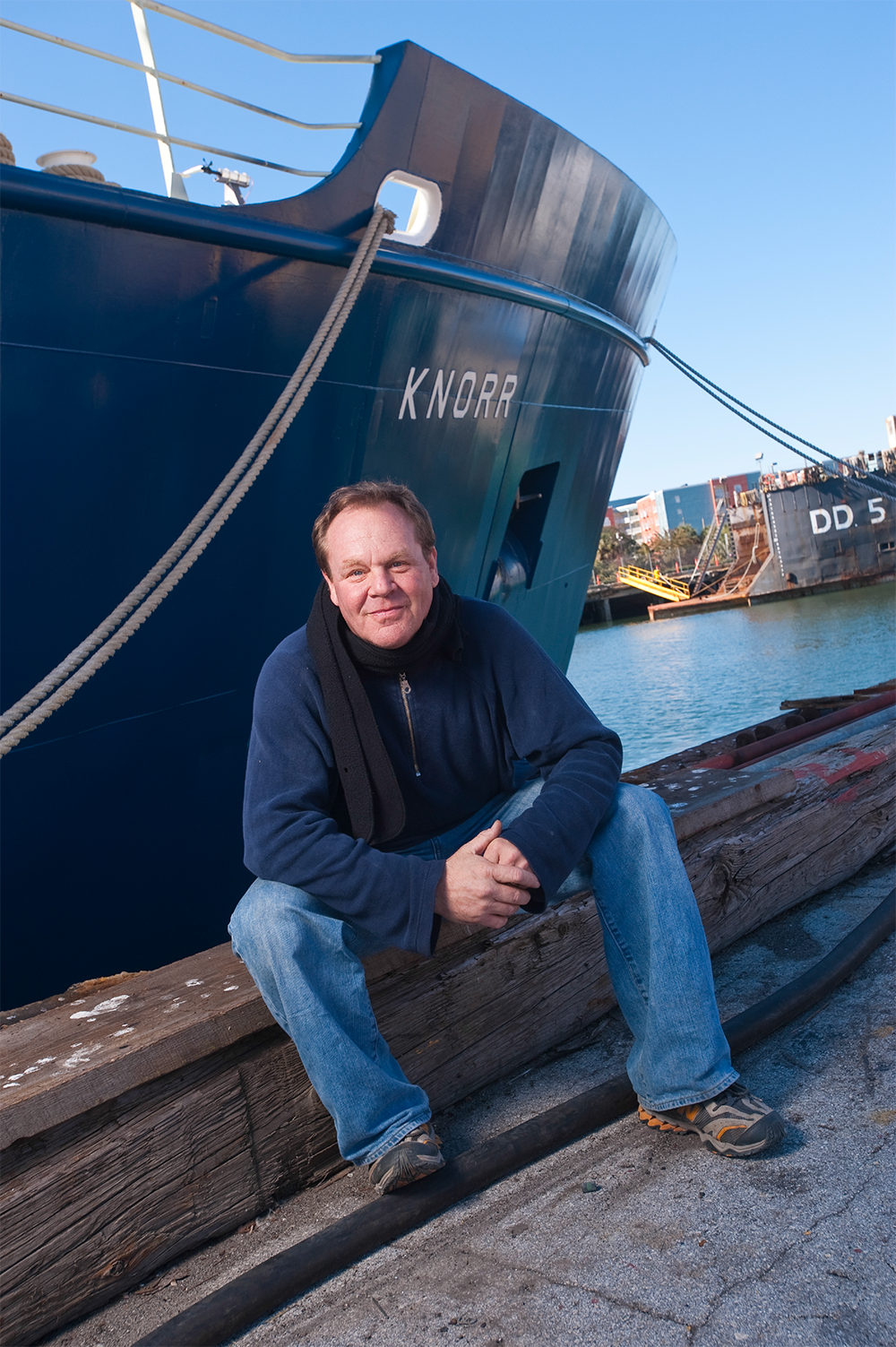
David Hollander is an Associate Professor of Chemical Oceanography at the University of South Florida. (Photo: courtesy of David Hollander)
HOLLANDER: I think that the take home message is that if in the event of deep water blowouts it is a complex series of chemical reactions that are occurring that can lead to really unpredicted consequences, and the standard cleanup procedures that we have can also lead to fairly unexpected consequences that we never recognize, namely the process of sedimentary oil deposition and that a significant component of the oil that's on the surface could actually return back to the sedimentary system and that this material can have a long-term biological and ecosystem consequence. If you're trying to save one part of the ecosystem you could very well jeopardize another one. With the use of the dispersants and the burning and the opening of the Mississippi...this was thought of as very little consequence to pushing this oil into the offshore regions but what we've been able to recognize is that indeed this oil has a fate and it does end up in the sediments and it is affecting biological systems and there is a consequence and ultimately there is an economic impact of this. The long-term good news is that the oil is essentially marching its way down the continental slope and so its ultimate destiny is to move into environments where there's lower biological activity but it's still there.
CURWOOD: David Hollander is a Professor of Marine Chemistry at the University of South Florida. Thanks so much for taking the time.
HOLLANDER: It's been a pleasure.
Links
USF College of Marine Science homepage
Living on Earth wants to hear from you!
Living on Earth
62 Calef Highway, Suite 212
Lee, NH 03861
Telephone: 617-287-4121
E-mail: comments@loe.org
Newsletter [Click here]
Donate to Living on Earth!
Living on Earth is an independent media program and relies entirely on contributions from listeners and institutions supporting public service. Please donate now to preserve an independent environmental voice.
NewsletterLiving on Earth offers a weekly delivery of the show's rundown to your mailbox. Sign up for our newsletter today!
 Sailors For The Sea: Be the change you want to sea.
Sailors For The Sea: Be the change you want to sea.
 The Grantham Foundation for the Protection of the Environment: Committed to protecting and improving the health of the global environment.
The Grantham Foundation for the Protection of the Environment: Committed to protecting and improving the health of the global environment.
 Contribute to Living on Earth and receive, as our gift to you, an archival print of one of Mark Seth Lender's extraordinary wildlife photographs. Follow the link to see Mark's current collection of photographs.
Contribute to Living on Earth and receive, as our gift to you, an archival print of one of Mark Seth Lender's extraordinary wildlife photographs. Follow the link to see Mark's current collection of photographs.
 Buy a signed copy of Mark Seth Lender's book Smeagull the Seagull & support Living on Earth
Buy a signed copy of Mark Seth Lender's book Smeagull the Seagull & support Living on Earth

